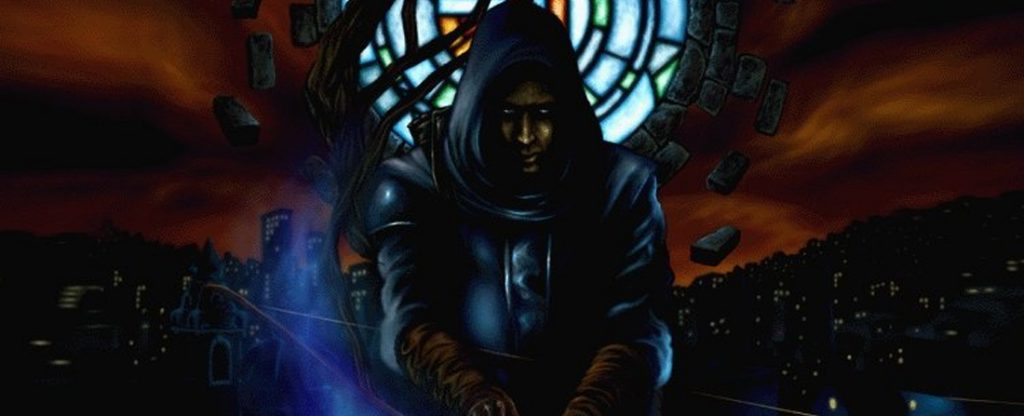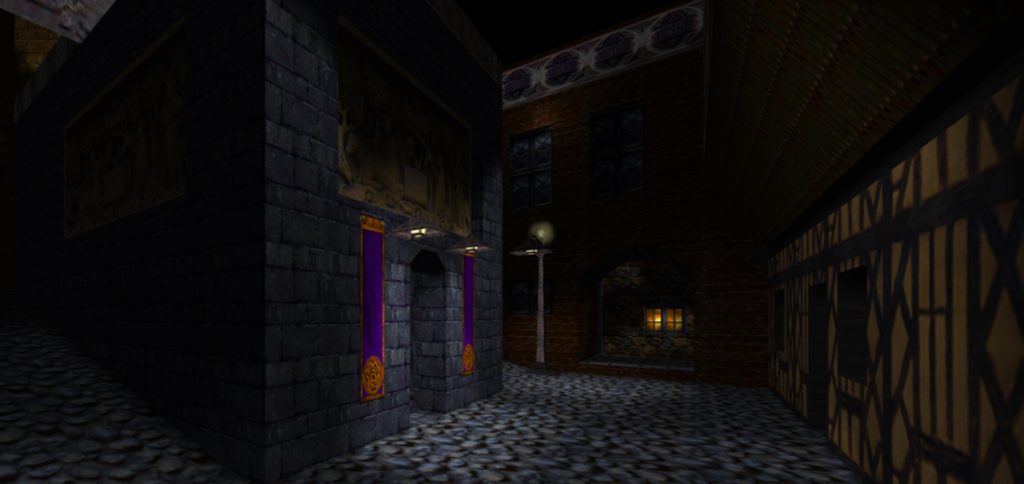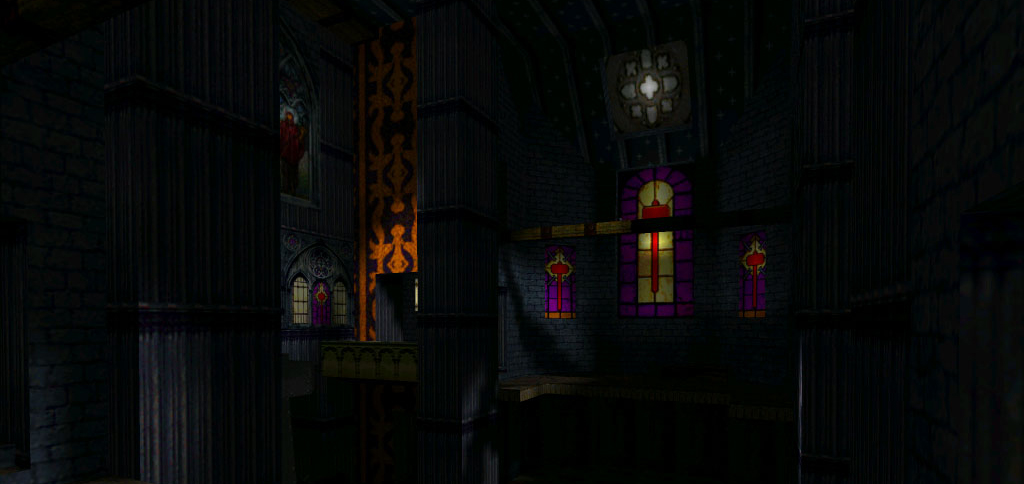Thief: The Dark Project is the 1998 debut in the critically acclaimed series created by Looking Glass Studios. It was one of the first stealth games ever made, along with Acquire’s 1986 Tenchu: Stealth Assassins.

As such, Thief is credited with spawning the entire genre, inspiring such games as Dishonored, Assassin’s Creed, Splinter Cell, Hitman, and many others.
Navigation
I. Gameplay
II. Setting
III. Story
IV. Development
V. Reception
VI. Thief Gold
VII. Walkthrough
Gameplay
In Thief: The Dark Project, players assume the role of anti-hero Garrett, a sardonic and world-weary thief whose connection to the cryptic Keeper faction fuels the story-driven gameplay over the course of thirteen missions.
It was the first game of its kind, combining compelling story-telling, non-confrontational gameplay, and player freedom to allow for emergent gameplay with un-scripted events.
Light, sound, and limited sword proficiency, forced players to remain aware of their surroundings and enemy patrol patterns to avoid combat in favor of concealment, misdirection, and evasion.
Guards and beasts were best dispatched through subtle takedowns using Garrett’s blackjack, or from a hidden distance with an arrow. Enemies were quick to note open doors, loud footsteps, fallen comrades, or the player lurking in a dimly lit shadow.
Players monitored their own visibility to AI with a light gem on the HUD, as well as enemy verbal cues or “barks,” which escalated proportionate to changes in the environment or suspicion of an intruder. Face-to-face combat was undesirable as Garrett took damage easily, and the noise was sure to attract the attention of other enemies.
Garrett’s goals, while avoiding detection, varied from mission to mission. Loot goals were consistent between missions, though plot-related goals varied as the story progressed; complete certain tasks, steal specific objects or documents, or break into and escape a location undetected.
Three difficulty settings determined the loot goal for each mission, affected Garrett’s starting health, added objectives, heightened enemy sensitivity, and tightened killing restrictions. In some missions, objectives changed to keep gameplay aligned with the unfolding story.

Setting
Thief was also unique for a first-person game in that story drove gameplay. The Dark Project takes place in the City, a medieval, steampunk dystopia where corrupt despots hoard treasures and monsters roam the sewers and outskirts. The game explores relationships between the City’s three main factions, the Keepers, the Hammerites, and the Pagans.
A hyper-religious order intent on bending the City to the will of the Builder, the Hammerites play judge, jury, and executioner while fighting the Pagan rebellion that thrives in its shadows. The Keeper’s role in the City is unclear, though they quote prophecy and warnings against extremism in the between-mission cutscenes that provide context and narrative for the story.
Despite his history with the Keepers, Garrett is loyal only to himself, though he has to carefully navigate the shifting politics and agendas at play.
Story
The game begins with Garrett describing his youth as an orphan on the City’s streets. He is caught while attempting to pickpocket a suspicious man who reveals himself to be a Keeper named Artemus.
Impressed, Artemus offers him the chance to join his order. Garrett accepts, but eventually leaves the order to pursue a life of thievery. Years later, Garrett is targeted for assassination by the crime lord Ramirez, but manages to evade the assassins and rob Ramirez’s mansion in retaliation.
Following this, he is approached by a woman named Viktoria who contracts him to steal a sword from an eccentric nobleman. After he does so, Viktoria takes him to the client, a man named Constantine who explains that he hired Garrett to steal his own sword as a test. He then offers him a fortune to steal the Eye, a gem locked within an abandoned Hammerite cathedral.
To reach it, Garrett ventures through Old Quarter, a deserted district of the City. Upon arriving at the cathedral, the Eye telepathically informs Garrett of a nearby Keeper sanctuary where he can learn how to open the cathedral. There, Garrett discovers that it was sealed to prevent the City’s destruction and that there are four talismans needed to break it.
After recovering the talismans and returning to the cathedral Garrett learns that its inhabitants were reanimated by the Eye. After claiming it he brings it to Constantine who reveals himself to be the Trickster. Viktoria says that the Eye requires a flesh eye, binds Garrett with vines, and proceeds to remove his right eye.
The Trickster places it on the gemstone, and the two disappear through a portal. Garrett, left for dead, is found and freed by two Keepers. He then learns that the Trickster plans to use the Eye to revert the world to a more chaotic and wild state.
After Garrett escapes the mansion he seeks help from the Hammerites but discovers that the Trickster attacked their temple. In a refuge beneath it he finds a few survivors who provide him with a trapped replica of the Eye.
Garrett then descends into the Maw of Chaos where he finds the Trickster performing a ritual with the Eye and stealthily substitutes the original with its copy, thereby killing the Trickster.
Sometime later, Artemus approaches Garrett and claims that he will soon require the Keepers’ help. Garrett dismisses him, and as he walks away, Artemus warns of the encroaching ‘metal age’.

Development
Originally conceived as an action role-playing game with first-person sword fighting, the game changed names and concepts several times before landing on Dark Camelot under the alternating leadership of Kevin Levine (Bioshock, System Shock II), Warren Spector (Ultima, Deus Ex, System Shock), and Doug Church (Ultima, System Shock).
Even so, Paul Nerath (Ultima, Terra Nova) is often credited with the desire to emphasize the sneaking aspects of the demo which ultimately led to the focus on thievery and stealth.
Development of the proprietary Dark Engine took place simultaneous to the game’s development, causing budget and time pressures.
Primarily written by Sean Barrett as early as 1995 to simulate real-life physics, allow integration with other user systems, the Dark Engine and it’s level editor, DromEd opened the door for a robust and enduring modding community within the fanbase for decades to come.
Reception
Thief: The Dark Project was released by publisher Eidos on December 1, 1998 and sold 88,000 units in 1999, reaching 500,000 sales by May 2000.
It remains Looking Glass Studio’s most critically acclaimed and commercially successful game and has since been lauded as an “unsurpassed achievement in gaming,” siting atop numerous “best of” and “top 100” game lists by GameSpy, PC Gamer, GameSpot, IGN, GamePro, Eurogamer, and even Time magazine.
Thief Gold
Thief Gold is the 1999 expanded re-release of Thief: The Dark Project, which was common for Eidos Interactive-published games at the time. It features numerous bug fixes and enhancements on the original game with many missions having their guard placements and patterns changed, areas re-textured, and some missions gaining whole new areas.
It also adds three new missions, fulfilling the original intent of the designers to have one mission per talisman.
- “Thieves’ Guild” features Garrett raiding the Downwind Thieves Guild’s sewer hideout, a group previously only read about in the Dark Project.
- “The Mage Towers” introduces a reclusive magicians sect known as The Hand Brotherhood to the game.
- “Song of the Caverns” has Garrett searching some underground caverns and the opera house built atop them.
Walkthrough
For a text walkthrough head over to the Keeper’s Chapel or download the strategy guide. For a guided video playthrough check out this playlist.
